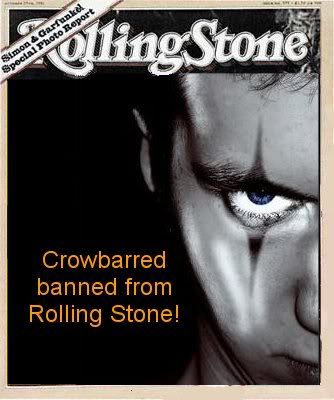Number 446 - Gary Moore

 Number 446
Number 446
Gary Moore
"Still Got The Blues (For You)"
(1990)
.
.
Genre:Blues
art by dogeatdog5
 Gazza 'ere. Nope, not even gonna moan about the amount of fragging airtime i have NOT had. Instead, lets talk about the worlds greatest guitarist ..... Gary Moore. Yes, i fragging said"Worlds Greatest". Forget Crowbarred's Joe Satriani & Richard Thompson, forget Rolling Stone's Bob Dylan & Jimi Hendrix, .... as one of my favourite film quote says "There can only be One".
Gazza 'ere. Nope, not even gonna moan about the amount of fragging airtime i have NOT had. Instead, lets talk about the worlds greatest guitarist ..... Gary Moore. Yes, i fragging said"Worlds Greatest". Forget Crowbarred's Joe Satriani & Richard Thompson, forget Rolling Stone's Bob Dylan & Jimi Hendrix, .... as one of my favourite film quote says "There can only be One". So, you're in one of the worlds biggest bands in the 70's & 80's, ya best mate and frontman for the band suddenly dies and you find yourself out of a job ... what would you do? Well, you ditch that old styles Rock, ya take up singing lessons and re-invent yourself as a world class blues guitarists. Easy.
Now before i go and let Crowbarred go back to his fragging *$&#@&**&% crappy music, here are some things you might not have known about Gary Moore. ~+ Gary was the protoge of Fleetwood Mac's Peter Green, who actually sold to Gary his 1959 Gibson Les Paul Sunburst. ~+ Although world famous, Gary Moore is hardly known by the most Americans [SHAME ON YOU #%$$@#^@]. ~+ Formed a short lived supergroup BBM with Cream's former rhythm section -- bassist Jack Bruce and drummer Ginger Baker -- which lasted for a single album. - - Till i fraggin' see ya till next time - Gazza.
Yea, i still got it
 One of rock's most underrated guitarists (both from a technical and compositional point of view), Gary Moore remains relatively unknown in the U.S., while his solo work has brought him substantial acclaim and commercial success in most other parts of the world -- especially in Europe. Born on April 4, 1952, in Belfast, Ireland, Moore became interested in guitar during the '60s, upon discovering such blues-rock masters as Eric Clapton, Jimi Hendrix, and perhaps his biggest influence of all, Fleetwood Mac's Peter Green. After relocating to Dublin later in the decade, Moore joined a local rock group called Skid Row, which featured a young singer by the name of Phil Lynott, who would soon after leave the group to double up on bass and form Thin Lizzy. Skid Row persevered, however, eventually opening a show for Moore's heroes, Peter Green and Fleetwood Mac, and making such an impression on the veteran group that Green personally requested their manager help secure Skid Row a recording contract with CBS (in addition, Green sold Moore one of his most-used guitars, a maple 1959 Gibson Les Paul Standard, which would become Moore's primary instrument).
One of rock's most underrated guitarists (both from a technical and compositional point of view), Gary Moore remains relatively unknown in the U.S., while his solo work has brought him substantial acclaim and commercial success in most other parts of the world -- especially in Europe. Born on April 4, 1952, in Belfast, Ireland, Moore became interested in guitar during the '60s, upon discovering such blues-rock masters as Eric Clapton, Jimi Hendrix, and perhaps his biggest influence of all, Fleetwood Mac's Peter Green. After relocating to Dublin later in the decade, Moore joined a local rock group called Skid Row, which featured a young singer by the name of Phil Lynott, who would soon after leave the group to double up on bass and form Thin Lizzy. Skid Row persevered, however, eventually opening a show for Moore's heroes, Peter Green and Fleetwood Mac, and making such an impression on the veteran group that Green personally requested their manager help secure Skid Row a recording contract with CBS (in addition, Green sold Moore one of his most-used guitars, a maple 1959 Gibson Les Paul Standard, which would become Moore's primary instrument).What train?
Moore hooked up once more with ex-bandmate Lynott in Thin Lizzy. Moore's initial tenure in Lizzy proved to be short-lived, however, as his fiery playing was featured on only a handful of tracks. Moore then set his sights on studio work (appearing on Eddie Howell's 1975 release, Gramaphone Record), before joining up with a prog rock/fusion outfit, Colosseum II. But once more, Moore's tenure in his latest outfit was fleeting; he appeared on only three recordings (1976's Strange New Flesh, plus a pair in 1977, Electric Savage and War Dance), as Moore accepted an invitation by his old buddy Lynott to fill in for a Thin Lizzy U.S. tour, playing arenas opening for Queen. Moore proved to be quite busy in 1978, as the guitarist appeared on three other artists' recordings -- Andrew Lloyd Webber's Variations, Rod Argent's (from the Zombies) Moving Home, and Gary Boyle's Electric Glide. The same year, Moore issued his second solo release (almost five years after his solo debut), Back on the Streets, which spawned a surprise Top Ten U.K. hit in May of 1979, the bluesy ballad "Parisienne Walkways," and featured vocal contributions by Lynott. Moore joined forces with his Lizzy mates once more in 1979, appearing on arguably the finest studio album of their career, Black Rose, which proved to be a huge hit in the U.K. (for a fine example of Moore's exceptional guitar skills, check out the album's epic title track).
After Thin Lizzy
Give me your jacket T3
Fed up with the pressure to pen hit singles and tired of his metallic musical direction, Moore returned to his blues roots for 1990's Still Got the Blues, the most renowned and best-selling release of his career, as the album featured such special guests as Albert Collins, Albert King, and George Harrison. Moore continued in his newly rediscovered blues style on such subsequent releases as 1992's After Hours and 1993's Blues Alive, before forming the short-lived supergroup BBM along with Cream's former rhythm section. -- which lasted for a single album, 1994's Around the Next Dream. Up next for Moore was a tribute album for Peter Green, 1995's Blues for Greeny, which saw him put his own personal stamp on 11 tracks either penned or performed at some point by Green. Moore experimented with different musical styles on his next two solo releases, 1997's Dark Days in Paradise and 1999's A Different Beat, before embracing the blues once more on his first release of the 21st century, 2001's Back to the Blues. ~ [Greg Prato, All Music Guide]
For more Gary Moore & Phil Lynott see Number 738
For Joe Satriani see Number 477 & #688
For Richard Thompson see Number 683
For Bob Dylan see Number 491, #841 & #929
For Jimi Hendrix see Number 718
For Fleetwood Mac see Number 514, #547 & #591
For Cream see Number 554
For Eric Clapton see Number 537
For Queen see Number 539, #747, #799 & #805
For The Zombies see Number 700  What does Rolling Stone think of Gary Moore?
What does Rolling Stone think of Gary Moore?
For George Harrison see Number 806
 What does Rolling Stone think of Gary Moore?
What does Rolling Stone think of Gary Moore? Rolling Stone had no view on Gary Moore, proving even more that Americans have heard little about this outstanding artist. Here is an excerpt from their [RS] offshoot Rhapsody. Moore has always enjoyed a devout following among guitarists, from his early swashbuckling days as Thin Lizzy's lead guitarist to his many rock, Fusion, and blues solo projects. Moore's balance of technically savvy licks and raw, emotional soul keeps the fans rabid. It was Still Got the Blues (1990) that finally solidified Gary Moore's reputation as a top-flight guitarist, achieving critical and commercial success with a back to the basics approach that put Moore's fiery Blues Rock guitar front and center. Later albums continue with that approach, including After Hours (1992), which featured heavy-hitting guests including B.B. King and Albert Collins. ~ [Source Rhapsody - Jessy Terry]
Rolling Stone magazine deemed their '446th Song of all Time' was "Pressure Drop" by Toot and the Maytals. Toot and the Maytals has not appeared in The Definitive 1000
Other songs with reference to Gary Moore #905
Rolling Stone Top 500 Songs ranked this song at Number (Who is Gary Moore?) and the Album ranked at (Oh.. The guy from this Thin Lizzy .. I thought he was, uh-nvm)
This song has a Definitive 1000 rating of 77.2 out of 108
Tags:Gary Moore, 1990, Blues, Cream, Bob Dylan, Jimi Hendrix, Eric Clapton, Fleetwood Mac,YouTube, Music Video, Rolling Stone Magazine, Crowbarred, New Zealand, Crowbarred Unleashed, The Definitive 1000 Songs Of All Time, Mellow Mix Volume 1, Mellow Mix Volume 2, Mellow Mix Volume 3, Mellow Mix Volume 4, Mellow Mix Volume 5, Mellow Mix Volume 6, Mellow Mix Volume 7, Mellow Mix Volume 9, Mellow Mix Volume 10, Mellow Mix Volume 11, Mellow Mix Volume 12 Gary Moore, 1990, Blues, Bob Dylan, Richard Thompson, Queen, Fleetwood Mac, Crowbarred, The Definitive 1000 Songs Of All Time
Search by Genre: ALT POP-ALT PUNK-ALT ROCK-ALTERNATIVE-BIZARRE-BLUES-BRIT POP-COMEDY-COUNTRY-CROONER-DANCE-DISCO-DO WOP-ELECTRONIA-FOLK SINGER-FOLK ROCK-FUNK-GARAGE ROCK-GLAM ROCK-GOSPEL-GRUNGE-GUITARIST-HAIR ROCK-HARD ROCK-HIP HOP-INDIE POP-INDIE ROCK-INDUSTRIAL ROCK- INSTRUMENTAL-JAZZ-LAZY SUNDAY-NEW WAVE-NU ROCK-POP-POP ROCK-PROG ROCK-PSYCHEDELIC ROCK-PUNK POP-PUNK ROCK-R&B-RAP-REGGAE-ROCK-ROCK N ROLL-SINGER SONGWRITER-SKA ROCK-SKIFFLE-SOFT ROCK-SOUL-SOUTHERN ROCK-SURF ROCK-SYNTH POP-TENOR-VOCAL
By The Year 1955 to 2005:
1955, 1956, 1957, 1958, 1959, 1960, 1961, 1962, 1963, 1964, 1965, 1966, 1967, 1968, 1969, 1970, 1971, 1972, 1973, 1974, 1975, 1976, 1977, 1978, 1979, 1980, 1981, 1982, 1983, 1984, 1985, 1986, 1987, 1988, 1989, 1990, 1991, 1992, 1993, 1994, 1995, 1996, 1997, 1998, 1999, 2000, 2001, 2002, 2003, 2004, 2005

underlay trademe
Labels: Gary Moore 446



















0 Comments:
Post a Comment
<< Home